
Unless otherwise stated, images by John Reeve on this site are licensed under a Creative Commons Attribution-NonCommercial-NoDerivs 3.0 Unported License. ... more info ...
Here is the selection of favourite images
that appeared in
the Home
page “Feature Photo” spot in 2016.
Posted December 30th, 2016

 +
(Click on Image)
+
(Click on Image)
Welcome to Dawson City
Yes, this “building” is
in fact a road sign which welcomes visitors arriving at the boundary of
Dawson City on the Klondike Highway. Well, this view actually shows the
back side of the sign which tells those who are departing “Thanks for
visiting Dawson City”.
Still getting accustomed to my new camera in early September, I had not noticed that the exposure mode I had selected for this shoot was set to record JPEG rather than RAW image files, which I always choose for their much better malleability in post-processing. This is especially important for nighttime images that typically require significant adjustment of very low level dark tones and are already compromised by high ISO settings. But these K-1 JPEGs held up better than I expected, even with substantial lightening of the building/sign to lift it out of the shadows. Mind you, the brightness of the aurora and the wide aperture of the lens led me to use ISO 800, which really is not very high for this camera.
Pentax K-1, Rokinon 24mm f/1.4 UMC, 4 sec @ f/1.6, ISO 800
Posted December 30th, 2016

 +
(Click on Image)
+
(Click on Image)
Dead Paddlewheeler
Just downstream from Dawson
City on the west bank of the Yukon River lies the “Paddlewheel
Graveyard”. Here, the remains of several abandoned paddlewheelers decay
amongst the trees that have overgrown the site. Most of them are
shattered and rotted beyond recognition; some are marked by nothing
more than scattered remnants of boards, almost completely reclaimed by
the boggy ground. The one whose wheelhouse and stack are depicted in
this silhouette is decidedly the most intact of the lot.
Pentax K-1, SMC Pentax DA* 60-250mm f/4 ED [IF] SDM @ 60mm, f/8
Posted December 24th, 2016
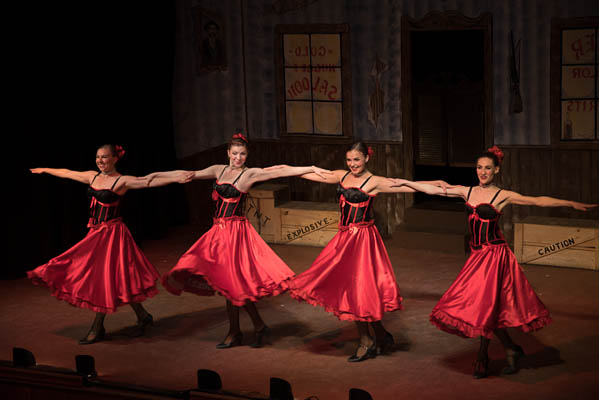
 +
(Click on Image)
+
(Click on Image)
Showgirls
Pentax K-1, Pentax HD D FA 28-105mm f/3.5-5.6 ED DC WR @ 73mm, 1/60 s @ f/5.6, ISO 640
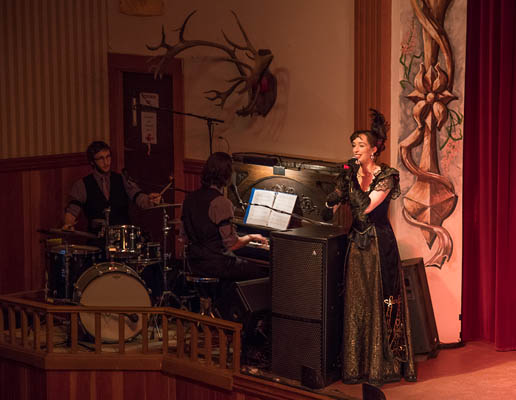
 +
(Click on Image)
+
(Click on Image)
Gold Rush Music
Pentax K-1, Pentax HD D FA 28-105mm f/3.5-5.6 ED DC WR @ 95mm, 1/60 s @ f/5.6, ISO 2000
Diamond Tooth Gerties gambling hall in Dawson City maintains the flavour of the Klondike Gold Rush era. Throughout the tourist season, they present thrice nightly vaudeville shows with music, dance and costumes hearkening back to that period.
Posted December 20th, 2016
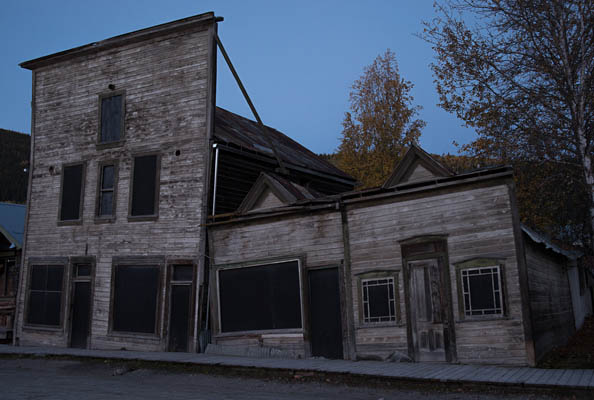
 +
(Click on Image)
+
(Click on Image)
Dawson Dilapidated
Pentax K-1, Pentax HD D FA 28-105mm f/3.5-5.6 ED DC WR @ 34mm, 1/6 s @ f/8, ISO 1250
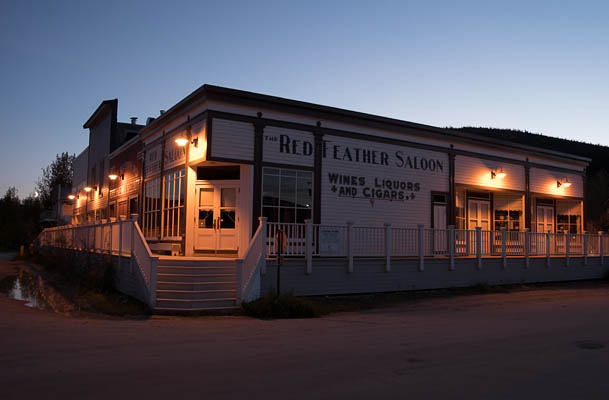
 +
(Click on Image)
+
(Click on Image)
Dawson Reconstructed
Pentax K-1, Pentax HD D FA 28-105mm f/3.5-5.6 ED DC WR @ 28mm, 1/8 s @ f/8, ISO 1250
Dawson City’s heritage buildings that date back to the Klondike gold rush are protected under the guidance of Parks Canada. They include abandoned, broken down structures that have undergone no repairs other than stabilization, and others that have been restored to pristine condition. The 3rd Avenue Hotel Complex (top photo) is a popularly viewed example of the former. The builders of the time did not understand the issues associated with building on permafrost, and when interior heating melted the ice below, the foundations sunk unevenly. This resulted in the inconsistent tilting of the different sections of this structure. The ruins of the original Red Feather Saloon, on the other hand, were removed and the building was reconstructed from scratch, incorporating only some token original materials.
These images were photographed hand-held in twilight, benefiting from the Pentax K-1’s excellent in-body image stabilization.
Posted November 21st, 2016
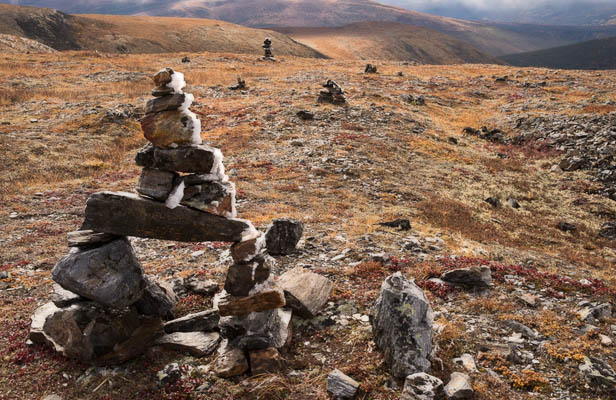
 +
(Click on Image)
+
(Click on Image)
Inuksuit on Top of the World
The Taylor Highway
turns into the Top of the World Highway and crosses from Alaska into
the Yukon on its way to our destination of Dawson City. The Top of the
World Highway derives its name from the fact that it follows high
ground, with frequent expansive views on both sides of the road. Just
inside the Canadian border, where the elevation is particularly high,
we noticed a white encrustation on one side of the sparse, little
trees, which we came to realize was a heavy coating of solid ice. The
air was cold enough that apparently it was condensing out of the misty
atmosphere, continuously supplied by a stiff wind. We pulled off at the
top of the hill and came upon this field full of inuksuit. (I only
recently learned that this is the proper pluralization of inukshuk.) I
processed this image with the same digital dreamscape technique I
described for the preceding Feature Photo, Autumn Renewal, but I
applied it much more subtly in this case and masked it out almost
completely in parts of the foreground inukshuk. I feel that the effect
supports the mystical quality of the scene. The smoothing and blending
of the colour imparts a warm and gentle impression to the scene, which
perhaps belies the bitterly chilling conditions, though the ice on the
rocks reveals that truth.
Pentax K-1, Pentax HD D FA 28-105mm f/3.5-5.6 ED DC WR @ 45mm, f/11, ISO 400
Posted November 21st, 2016
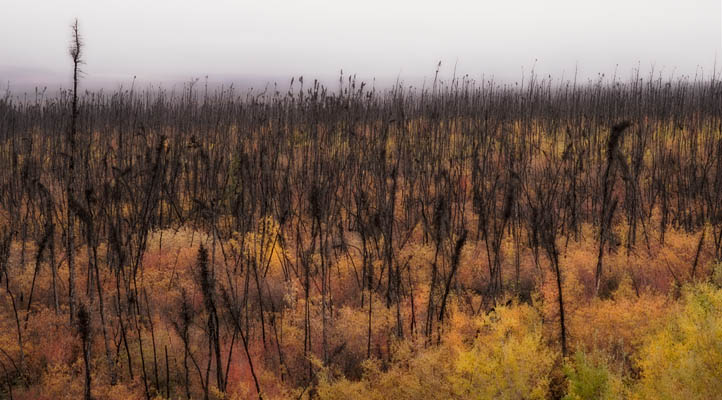
 +
(Click on Image)
+
(Click on Image)
Autumn Renewal
After traveling past Sheep
Mountain with my visiting friends, we continued up the Alaska Highway
into Alaska and then turned off onto the Taylor Highway. This region is
forested with generally stunted and spindly spruce. Forest fires in
recent years have charred vast areas. But deciduous vegetation soon
thrives in the open and ash-fertilized burn zones. In early September,
it treated us to a fresh, magnificent tapestry of colour, contrasted
against the stark, blackened tree skeletons. No smoke at this time, but
fog was widely dispersed the day we passed through here and that is
what softened the background in this image. Otherwise, the image was
softened by my post-processing technique, in which I combined the photo
with a blurred copy of itself. Many long time photographers will
recognize this as comparable to an old in-camera film technique known
as “Orton Imaging”, or an alternate method that involves sandwiching
transparencies. André Gallant calls the technique I used “digital
dreamscapes”. It can also be done the old way using a digital camera
that has multi-exposure capability, and I have had some success trying
that too. The effect is not identical amongst the different approaches.
The great advantage of the post-processing method is that it can be
applied to any digital image after the fact. I was inspired to do it in
this case to emphasize the glorious, uplifting wash of colour over the
landscape that represents the new life, whilst minimizing the
distraction of the haphazard clutter of the new growth and
de-emphasizing the solemn starkness of the burnt trees.
Pentax K-1, Pentax HD D FA 28-105mm f/3.5-5.6 ED DC WR @ 73mm, f/11, ISO 400
Posted October 30th, 2016
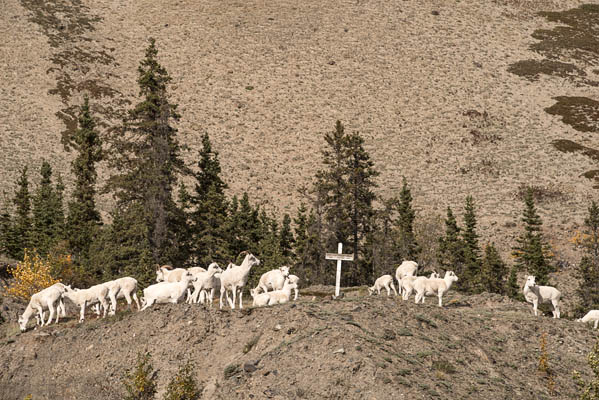
 +
(Click on Image)
+
(Click on Image)
The Flock
I was surprised to see the Dall sheep
down near the highway in early September at Sheep Mountain on the edge
of Kluane Park. They usually spend the summer in rich feeding grounds
on a plateau over the other side of the mountain, and only come down
when winter sets in. But low water levels in Kluane Lake, due to a
natural diversion of the Slims River which feeds the lake, apparently
have exposed mineral licks that have drawn the sheep down. I believe
the cross is a memorial to a worker who perished at this location
during the original construction of the Alaska Highway.
I shot this image while traveling through the Yukon and Alaska with guests visiting me from Ontario. Hosting them contributed to an extra busy late summer and fall, which is my excuse for another long gap since the last time I posted to this site. But I took a large number of photos with my new camera during these travels and I plan to add a few more of them here in a flurry of more frequent Feature Photos over the coming weeks.
Pentax K-1, SMC Pentax DA* 60-250mm f/4 ED [IF] SDM @ 170mm, 1/250 sec @ f/11, ISO 200
Posted August 4th, 2016
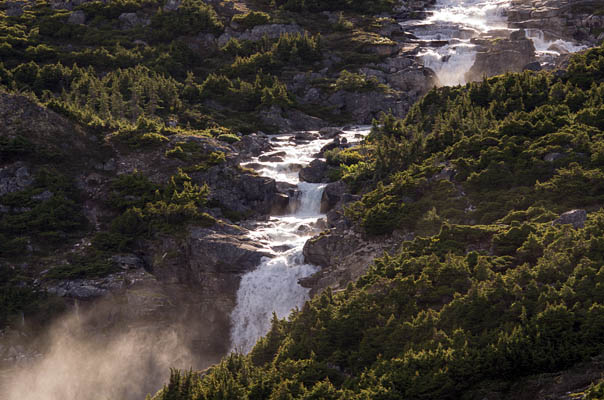
 +
(Click on Image)
+
(Click on Image)
White Pass Waterfall
This photo shows just a
part of the river’s long cascade down a mountainside near the White
Pass summit. It was shot from the South Klondike Highway, on the
Canadian side of the border with Alaska. The backlight from the evening
sun produced blinding reflections off the water, in extreme contrast to
the dark shadows under the trees and cliffs.That made exposure and
post-processing quite tricky, but the scene was exhilarating to behold
and I think I managed to capture a good part of its essence in this
final image. It was late June when I made this exposure; lately I seem
to have a hard time getting around to processing my photos and posting
to this site.
Pentax K-5, Sigma 150-500mm f/5-6.3 APO DG OS HSM @ 150mm, 1/250 sec @ f/5.6
Posted May 29th, 2016
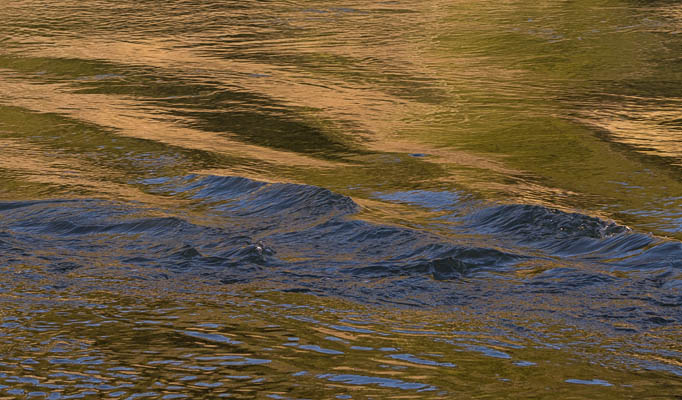
 +
(Click on Image)
+
(Click on Image)
Landscape in a River
Here is a bonus second Feature Photo post on this date, to help fill in the over two months gap following my previous entry.
When our scheduled presenter for the May main meeting of the Whitehorse Photography Club had to cancel on short notice, members were notified to bring their camera equipment for an impromptu photo shoot instead. The Yukon River runs right behind the Whitehorse Public Library, our regular meeting venue, and photographic opportunities abound right there along the river’s edge. The evening light was superb. The low sun warmly lit up the trees and clay cliffs above the opposite bank. These reflected as a wash of colours in the turbulent water, producing this impressionistic image.
Pentax K-5, SMC Pentax DA* 60-250mm f/4 ED [IF] SDM, 1/180 sec @ f/9.5, ISO 400
Posted May 29th, 2016
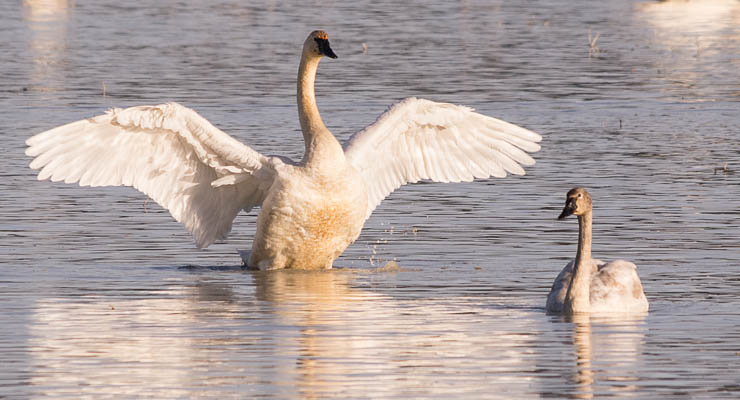
 +
(Click on Image)
+
(Click on Image)
Beauty and Grace ... and maybe Hormones
It has
been a couple of busy months since I last posted anything on this site,
but that does not mean I have not been shooting pictures. This one
dates back to April 20th, when I headed out to Swan Haven on Marsh Lake
to photograph the Trumpeter Swans while they were staging there on
their annual spring migration. They have this ritual of periodically
spreading and flapping their wings while rising high in the water. I
have seen a number of explanations for this sort of behaviour, but in
this case it is probably a mating display. It is beautiful to behold
and the light that evening was wonderful for photography.
Pentax K-5, Sigma 150-500mm f/5-6.3 APO DG OS HSM, 1/500 sec @ f/9.5, ISO 400
Posted March 20th, 2016
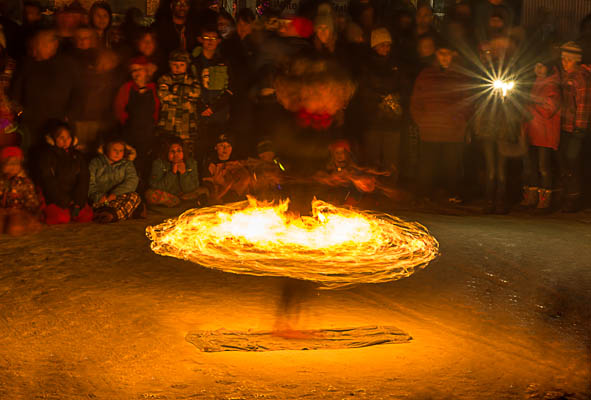
 +
(Click on Image)
+
(Click on Image)
Dance with Fire
A long exposure dissolved this
spinning fire dancer into a nebulous axle for the disk of fire trails
she was tracing, as the rapt audience peered from the shadows. The fire
dancing performance was a prelude to the featured fireworks display,
held at the recent Yukon Sourdough Rendezvous festival.
Pentax K-5, Tamron AF 17-50mm f/2.8 XR Di-II LD, 8.0 sec @ f/13, ISO 80
Posted February 21st, 2016
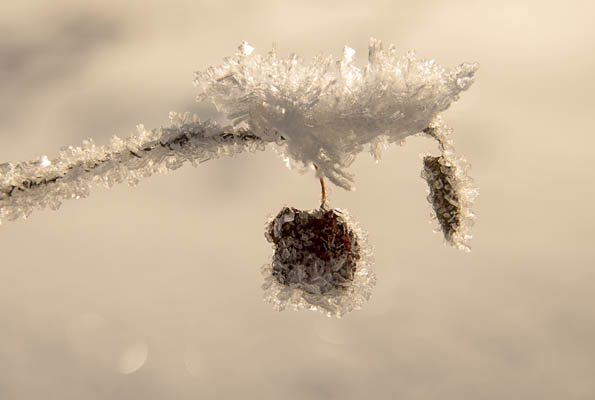
 +
(Click on Image)
+
(Click on Image)
Hoary Twig Tip
A companion to the preceding
Feature Photo, this one was made using the same focus stacking
technique, combining 8 hand-held exposures. The Tamron AF 17-50mm f/2.8
standard zoom lens focuses close enough to provide this magnification
of the small subject (actually it is slightly cropped). And shot at a
wide aperture, it also is able to produce the smooth, unfocused
background you see here, though that also necessitated the focus
stacking to render the subject adequately sharp from front to back.
Pentax K-5, Tamron AF 17-50mm f/2.8 XR Di-II LD @ f/4
Posted January 31st, 2016
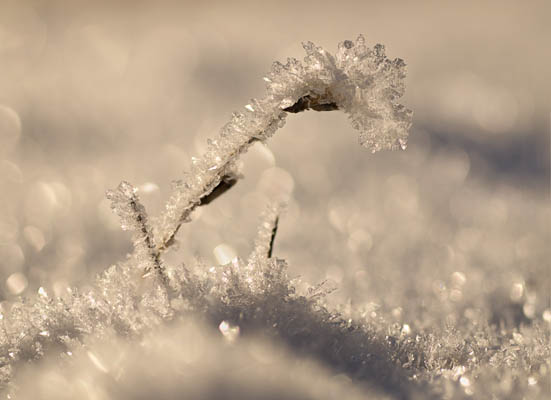
 +
(Click on Image)
+
(Click on Image)
Tiny Frosty Landscape
The tiny remnants of last
season’s plant life poke through a thin cover of snow atop a barren
hillside, and all is coated with hoarfrost. The scale of this scene is
miniature enough that my macro lens was mere inches from the subject
while I lay on the snow photographing it. The depth of sharp focus is
very thin in such close-up situations, especially with the lens set at
the wide aperture I wanted to use to produce a pleasant background with
circular out-of-focus highlights. The solution was to take multiple
frames, varying the focus point to cover the range of focus I wanted to
capture, and combine them by focus stacking in Photoshop. At this very
close distance and without my tripod, the easiest way to change focus
is not with the focus ring but rather by moving the camera relative to
the subject. Starting with the closest parts of the subject in sharp
focus, I slowly rocked forward, pivoting on my elbow which was
supporting me on the ground, while shooting in continuous drive mode
until I was confident I had covered the full range of sharpness I
needed. Only bits of these shots were sharp, but 8 of them combined to
produce the image you see above.
Pentax K-5, Sigma AF 70mm f/2.8 EX DG Macro @ f/3.5
Note: When you click on
any image it will open the enlarged version in a new window with
navigation buttons to advance through the larger photos. For optimal
display
and full functionality make sure you have javascript enabled in your
browser.
Posted December 30th, 2016

 +
(Click on Image)
+
(Click on Image)Welcome to Dawson City
Yes, this “building” is
in fact a road sign which welcomes visitors arriving at the boundary of
Dawson City on the Klondike Highway. Well, this view actually shows the
back side of the sign which tells those who are departing “Thanks for
visiting Dawson City”.Still getting accustomed to my new camera in early September, I had not noticed that the exposure mode I had selected for this shoot was set to record JPEG rather than RAW image files, which I always choose for their much better malleability in post-processing. This is especially important for nighttime images that typically require significant adjustment of very low level dark tones and are already compromised by high ISO settings. But these K-1 JPEGs held up better than I expected, even with substantial lightening of the building/sign to lift it out of the shadows. Mind you, the brightness of the aurora and the wide aperture of the lens led me to use ISO 800, which really is not very high for this camera.
Pentax K-1, Rokinon 24mm f/1.4 UMC, 4 sec @ f/1.6, ISO 800
Posted December 30th, 2016

 +
(Click on Image)
+
(Click on Image)Dead Paddlewheeler
Just downstream from Dawson
City on the west bank of the Yukon River lies the “Paddlewheel
Graveyard”. Here, the remains of several abandoned paddlewheelers decay
amongst the trees that have overgrown the site. Most of them are
shattered and rotted beyond recognition; some are marked by nothing
more than scattered remnants of boards, almost completely reclaimed by
the boggy ground. The one whose wheelhouse and stack are depicted in
this silhouette is decidedly the most intact of the lot.Pentax K-1, SMC Pentax DA* 60-250mm f/4 ED [IF] SDM @ 60mm, f/8
Posted December 24th, 2016

 +
(Click on Image)
+
(Click on Image)Showgirls
Pentax K-1, Pentax HD D FA 28-105mm f/3.5-5.6 ED DC WR @ 73mm, 1/60 s @ f/5.6, ISO 640
 +
(Click on Image)
+
(Click on Image)Gold Rush Music
Pentax K-1, Pentax HD D FA 28-105mm f/3.5-5.6 ED DC WR @ 95mm, 1/60 s @ f/5.6, ISO 2000Diamond Tooth Gerties gambling hall in Dawson City maintains the flavour of the Klondike Gold Rush era. Throughout the tourist season, they present thrice nightly vaudeville shows with music, dance and costumes hearkening back to that period.
Posted December 20th, 2016

 +
(Click on Image)
+
(Click on Image)Dawson Dilapidated
Pentax K-1, Pentax HD D FA 28-105mm f/3.5-5.6 ED DC WR @ 34mm, 1/6 s @ f/8, ISO 1250
 +
(Click on Image)
+
(Click on Image)Dawson Reconstructed
Pentax K-1, Pentax HD D FA 28-105mm f/3.5-5.6 ED DC WR @ 28mm, 1/8 s @ f/8, ISO 1250Dawson City’s heritage buildings that date back to the Klondike gold rush are protected under the guidance of Parks Canada. They include abandoned, broken down structures that have undergone no repairs other than stabilization, and others that have been restored to pristine condition. The 3rd Avenue Hotel Complex (top photo) is a popularly viewed example of the former. The builders of the time did not understand the issues associated with building on permafrost, and when interior heating melted the ice below, the foundations sunk unevenly. This resulted in the inconsistent tilting of the different sections of this structure. The ruins of the original Red Feather Saloon, on the other hand, were removed and the building was reconstructed from scratch, incorporating only some token original materials.
These images were photographed hand-held in twilight, benefiting from the Pentax K-1’s excellent in-body image stabilization.
Posted November 21st, 2016

 +
(Click on Image)
+
(Click on Image)Inuksuit on Top of the World
The Taylor Highway
turns into the Top of the World Highway and crosses from Alaska into
the Yukon on its way to our destination of Dawson City. The Top of the
World Highway derives its name from the fact that it follows high
ground, with frequent expansive views on both sides of the road. Just
inside the Canadian border, where the elevation is particularly high,
we noticed a white encrustation on one side of the sparse, little
trees, which we came to realize was a heavy coating of solid ice. The
air was cold enough that apparently it was condensing out of the misty
atmosphere, continuously supplied by a stiff wind. We pulled off at the
top of the hill and came upon this field full of inuksuit. (I only
recently learned that this is the proper pluralization of inukshuk.) I
processed this image with the same digital dreamscape technique I
described for the preceding Feature Photo, Autumn Renewal, but I
applied it much more subtly in this case and masked it out almost
completely in parts of the foreground inukshuk. I feel that the effect
supports the mystical quality of the scene. The smoothing and blending
of the colour imparts a warm and gentle impression to the scene, which
perhaps belies the bitterly chilling conditions, though the ice on the
rocks reveals that truth.Pentax K-1, Pentax HD D FA 28-105mm f/3.5-5.6 ED DC WR @ 45mm, f/11, ISO 400
Posted November 21st, 2016

 +
(Click on Image)
+
(Click on Image)Autumn Renewal
After traveling past Sheep
Mountain with my visiting friends, we continued up the Alaska Highway
into Alaska and then turned off onto the Taylor Highway. This region is
forested with generally stunted and spindly spruce. Forest fires in
recent years have charred vast areas. But deciduous vegetation soon
thrives in the open and ash-fertilized burn zones. In early September,
it treated us to a fresh, magnificent tapestry of colour, contrasted
against the stark, blackened tree skeletons. No smoke at this time, but
fog was widely dispersed the day we passed through here and that is
what softened the background in this image. Otherwise, the image was
softened by my post-processing technique, in which I combined the photo
with a blurred copy of itself. Many long time photographers will
recognize this as comparable to an old in-camera film technique known
as “Orton Imaging”, or an alternate method that involves sandwiching
transparencies. André Gallant calls the technique I used “digital
dreamscapes”. It can also be done the old way using a digital camera
that has multi-exposure capability, and I have had some success trying
that too. The effect is not identical amongst the different approaches.
The great advantage of the post-processing method is that it can be
applied to any digital image after the fact. I was inspired to do it in
this case to emphasize the glorious, uplifting wash of colour over the
landscape that represents the new life, whilst minimizing the
distraction of the haphazard clutter of the new growth and
de-emphasizing the solemn starkness of the burnt trees.Pentax K-1, Pentax HD D FA 28-105mm f/3.5-5.6 ED DC WR @ 73mm, f/11, ISO 400
Posted October 30th, 2016

 +
(Click on Image)
+
(Click on Image)The Flock
I was surprised to see the Dall sheep
down near the highway in early September at Sheep Mountain on the edge
of Kluane Park. They usually spend the summer in rich feeding grounds
on a plateau over the other side of the mountain, and only come down
when winter sets in. But low water levels in Kluane Lake, due to a
natural diversion of the Slims River which feeds the lake, apparently
have exposed mineral licks that have drawn the sheep down. I believe
the cross is a memorial to a worker who perished at this location
during the original construction of the Alaska Highway. I shot this image while traveling through the Yukon and Alaska with guests visiting me from Ontario. Hosting them contributed to an extra busy late summer and fall, which is my excuse for another long gap since the last time I posted to this site. But I took a large number of photos with my new camera during these travels and I plan to add a few more of them here in a flurry of more frequent Feature Photos over the coming weeks.
Pentax K-1, SMC Pentax DA* 60-250mm f/4 ED [IF] SDM @ 170mm, 1/250 sec @ f/11, ISO 200
Posted August 4th, 2016

 +
(Click on Image)
+
(Click on Image)White Pass Waterfall
This photo shows just a
part of the river’s long cascade down a mountainside near the White
Pass summit. It was shot from the South Klondike Highway, on the
Canadian side of the border with Alaska. The backlight from the evening
sun produced blinding reflections off the water, in extreme contrast to
the dark shadows under the trees and cliffs.That made exposure and
post-processing quite tricky, but the scene was exhilarating to behold
and I think I managed to capture a good part of its essence in this
final image. It was late June when I made this exposure; lately I seem
to have a hard time getting around to processing my photos and posting
to this site.Pentax K-5, Sigma 150-500mm f/5-6.3 APO DG OS HSM @ 150mm, 1/250 sec @ f/5.6
Posted May 29th, 2016

 +
(Click on Image)
+
(Click on Image)Landscape in a River
Here is a bonus second Feature Photo post on this date, to help fill in the over two months gap following my previous entry.When our scheduled presenter for the May main meeting of the Whitehorse Photography Club had to cancel on short notice, members were notified to bring their camera equipment for an impromptu photo shoot instead. The Yukon River runs right behind the Whitehorse Public Library, our regular meeting venue, and photographic opportunities abound right there along the river’s edge. The evening light was superb. The low sun warmly lit up the trees and clay cliffs above the opposite bank. These reflected as a wash of colours in the turbulent water, producing this impressionistic image.
Pentax K-5, SMC Pentax DA* 60-250mm f/4 ED [IF] SDM, 1/180 sec @ f/9.5, ISO 400
Posted May 29th, 2016

 +
(Click on Image)
+
(Click on Image)Beauty and Grace ... and maybe Hormones
It has
been a couple of busy months since I last posted anything on this site,
but that does not mean I have not been shooting pictures. This one
dates back to April 20th, when I headed out to Swan Haven on Marsh Lake
to photograph the Trumpeter Swans while they were staging there on
their annual spring migration. They have this ritual of periodically
spreading and flapping their wings while rising high in the water. I
have seen a number of explanations for this sort of behaviour, but in
this case it is probably a mating display. It is beautiful to behold
and the light that evening was wonderful for photography.Pentax K-5, Sigma 150-500mm f/5-6.3 APO DG OS HSM, 1/500 sec @ f/9.5, ISO 400
Posted March 20th, 2016

 +
(Click on Image)
+
(Click on Image)Dance with Fire
A long exposure dissolved this
spinning fire dancer into a nebulous axle for the disk of fire trails
she was tracing, as the rapt audience peered from the shadows. The fire
dancing performance was a prelude to the featured fireworks display,
held at the recent Yukon Sourdough Rendezvous festival.Pentax K-5, Tamron AF 17-50mm f/2.8 XR Di-II LD, 8.0 sec @ f/13, ISO 80
Posted February 21st, 2016

 +
(Click on Image)
+
(Click on Image)Hoary Twig Tip
A companion to the preceding
Feature Photo, this one was made using the same focus stacking
technique, combining 8 hand-held exposures. The Tamron AF 17-50mm f/2.8
standard zoom lens focuses close enough to provide this magnification
of the small subject (actually it is slightly cropped). And shot at a
wide aperture, it also is able to produce the smooth, unfocused
background you see here, though that also necessitated the focus
stacking to render the subject adequately sharp from front to back.Pentax K-5, Tamron AF 17-50mm f/2.8 XR Di-II LD @ f/4
Posted January 31st, 2016

 +
(Click on Image)
+
(Click on Image)Tiny Frosty Landscape
The tiny remnants of last
season’s plant life poke through a thin cover of snow atop a barren
hillside, and all is coated with hoarfrost. The scale of this scene is
miniature enough that my macro lens was mere inches from the subject
while I lay on the snow photographing it. The depth of sharp focus is
very thin in such close-up situations, especially with the lens set at
the wide aperture I wanted to use to produce a pleasant background with
circular out-of-focus highlights. The solution was to take multiple
frames, varying the focus point to cover the range of focus I wanted to
capture, and combine them by focus stacking in Photoshop. At this very
close distance and without my tripod, the easiest way to change focus
is not with the focus ring but rather by moving the camera relative to
the subject. Starting with the closest parts of the subject in sharp
focus, I slowly rocked forward, pivoting on my elbow which was
supporting me on the ground, while shooting in continuous drive mode
until I was confident I had covered the full range of sharpness I
needed. Only bits of these shots were sharp, but 8 of them combined to
produce the image you see above.Pentax K-5, Sigma AF 70mm f/2.8 EX DG Macro @ f/3.5

